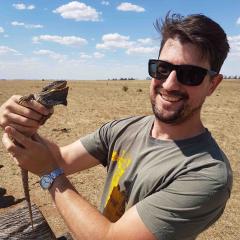Mum likes to remind me that I’m a worrywart. It’s true, I am. But it has only recently occurred to me that my passion for threatened species — now extending back well over two decades — may ultimately stem from that character trait. I worry about our threatened species because they are, by definition, in trouble. Maybe they have their own inherent frailties; maybe they can’t compete with some whizz bang new invasive; or maybe we humans have a penchant for their particular habitat. Whatever the case, they are imperilled, and my worrywart radar is triggered.
The upside is that constructive worrywartism — how I describe my affliction — motivates action. One of the key ways the constructive worrywart is pacified is through solving the problem. And so, for threatened species, my inner worrywart wants action. It asks, rather incessantly, “What can we do for these species?” Thankfully the answer is “lots” in most cases; we just need to work out what. And that, in a nutshell, describes my career to date.
From La Trobe to the University of York
I grew up in Melbourne’s northern suburbs, and after a decade filling Mum’s shed with pet snakes, took myself off to complete a Bachelor of Biological Sciences at La Trobe University (inexplicably missing Professor Martine Maron, who was there at the same time doing the same subjects). I focused on Zoology and, on completing my undergrad, had the great privilege of joining a radio-tracking study of threatened Inland carpet pythons for my Honours. From there, I worked as an ecological consultant for three years, before starting a PhD on growling grass frog conservation, again at La Trobe. It was heady days, and for a time I even shared a house with Professor Eve McDonald-Madden, just before her move to The University of Queensland.
With my stay at La Trobe drawing to a close in 2009, I sought to continue my work on growling grass frogs as a postdoc. I collaborated with Professors Kirsten Parris and Michael McCarthy at The University of Melbourne to win an ARC Linkage Grant, and spent the subsequent three years building a metapopulation model for the species. The work culminated in the use of our model by the Victorian Government to prioritise around $60 million of habitat creation works for growling grass frogs across Melbourne’s urban growth zones – just the outcome I hoped for.
In 2013, I was awarded a Victorian Postdoctoral Research Fellowship and travelled to the University of York to study at the knee of Professor Chris Thomas. These fellowships had tight eligibility criteria around “Victorian-ness”; one was almost ineligible for the mere thought of straying across the border. And so I, and several other conspicuously insular Victorians, were sent overseas to broaden our minds, make international connections and return to the antipodes with a bevy of papers. It was a terrific time, and one for which I partly have Professor Hugh Possingham to thank – the final year of this fellowship was supported by the ARC Centre of Excellence for Environmental Decisions (CEED), so thanks Hugh!
To TERN and the TSX, with a few steps in between
After my Victorian Postdoctoral Research Fellowship, I secured a Lectureship at Charles Sturt University in Albury teaching Wildlife Ecology and Management. However, after a happy two years career opportunities in Melbourne were calling us back. My wife Tanja joined The University of Melbourne and I fell in with the Arthur Rylah Institute for Environmental Research, spending two years with them as a Senior Scientist working on such things as koala abundance estimates and population viability analysis models for species impacted by windfarms. And then came the bombshell. Tanja secured a Senior Lectureship at Griffith University, and we were off to Queensland. We crossed the border the day it closed — 25March 2020.
My first 18 months in Queensland were spent working freelance on ecological modelling studies, with a six-month stint with the Australian Government’s NESP Threatened Species Recovery Hub working on bushfire impacts on rainforest frogs (under Dr Ben Scheele at the Australian National University). Then, in August 2021, the Project Manager position for the Threatened Species Index (TSX) was advertised and I hurried to submit an application before going on a month-long herping trip around Queensland. I did the interview from a motel room in Mackay and was offered the job the following day. I joined TERN and UQ in November 2021, to my great delight.
The TSX
You could be forgiven for thinking that being the Project Manager for the TSX is not the ideal position for a worrywart. Most ways you cut the data, the TSX shows that our threatened species continue to decline. Yet, the TSX is a terrific fit for me, because it is a powerful tool to stimulate action for our threatened species. When it produces graphs showing falling abundance, it demonstrates clearly that we must do more. When it produces graphs that show stable or even increasing abundance, it shows us that we can succeed. And it can even show us why we are failing or succeeding; it gives us insights into which actions work and which ones don’t. And so, my inner worrywart — constantly nagging me about what we can do for our threatened species — is satiated. It knows I’m helping to answer the question, and that conservation actions will follow.
View some of Geoff's photography here.

